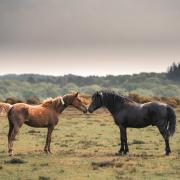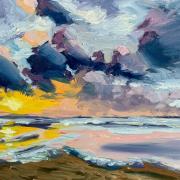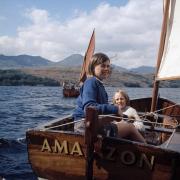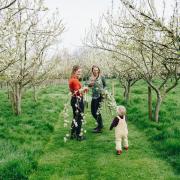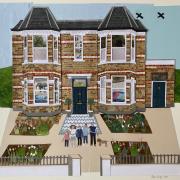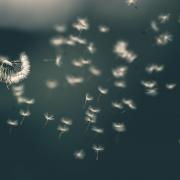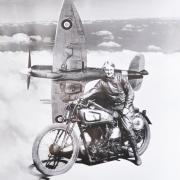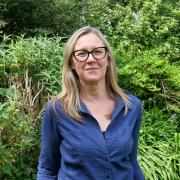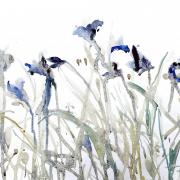Following his retirement and a move to New Milton, Tony Clegg was inspired to pick up a paintbrush. He talks to Sandra Smith about finding his own style

“Composition is one of the key elements for me. It’s the composition that makes a picture something we like, even if we don’t know why. So I might look at a landscape, take a few photographs then come back and plan it out. I do several thumb nail sketches and play about with the shape until it evolves. Sometimes the planning takes far longer than the painting.”
The impact of such extensive forethought and preparation manifests itself in deceptively uncomplicated images. Tony Clegg’s landscapes abound with effervescence. Is it the superficial naivety of his work that the viewer finds so irresistible? Those uncluttered images which lure the onlooker into the artist’s mindset? Or perhaps his application of primary colours, vibrantly embracing and reflecting their subject and creating depth of character via concentrated tones?
Tony’s inherent methodology and preoccupation with colour undoubtedly form the crux of his artistic output. A behind the scenes tactical approach, as systematic as it is patient and simultaneously combining nature and individuality, forms the foundation of some memorable work. But, while talking to this articulate 72 year old, I discover yet another element which contributes to his signature style: a rejection of representational art.
“If you have a painting of a photograph that is correct in every detail, no matter how clever that may be, it’s just copying so why bother? I try to add in some sort of artistic influence. Over time I abstract the image from the photograph until it becomes something else. This is not totally abstract as the painting is recognisable to some degree...but I like to think of it as a piece of art rather than just a photograph.”

The New Milton artist confesses to attending numerous demonstrations, workshops and classes since taking up painting when he retired 20 years ago, using every opportunity to learn new techniques and mix with other artists. When he moved to Hampshire after holidaying down here a number of times he went along to the Woodlanders Exhibition at Burley where he met Daphne Ellman, and for several years attended her classes. Daphne recalls her eager student: “Tony was a delight to teach. He came with the magic ingredients of raw talent and enthusiasm. He was always prepared to listen and pay attention to the basics and yet try out new ideas. As a result he has developed his own style which we see today.”
Initially drawn to watercolour (“Because I didn’t know anything at the time”), its subtle qualities, he reckons, are mirrored in those artists who favour the medium, declaring that people who paint in watercolour are generally gentle folk. This is certainly true of this quietly spoken, unhurried gentleman, even though his watercolours are some of the brightest you are likely to encounter. Indeed, you would be forgiven for thinking examples of his early work are acrylic. How did he achieve such strong tones?
“Simply by using more paint and less water. My watercolours mostly consist of graded washes and the difficulty is to eliminate brush marks so you get a perfectly smooth colour. First of all I wet the paper with clear water. Using a 2” wide brush to put on plenty of paint, I work it across the top of the paper with a gentle slope on the board. When wet the paper is stretched drum tight with gummed tape around the edge so there are no bubbles. Left to dry it shrinks so you can then add water without it waving about. Then I just paint my way down. I have an adapted photographic tripod for an easel which can be tipped in all directions enabling the paint to run down and give an even wash.”
As I admire the bright canvasses of Fields of Gold and Summer Breeze, the latter epitomising an idyllic English summer day, Tony talks me through the evolution of his early work.

“When I put some of my early paintings into exhibitions, it was a struggle to see them because your peripheral vision was disturbed by others around - mine just disappeared into the background, so I wondered what I could do to make them stand out from the crowd. I decided a lot of watercolours were wishy washy. There was also the question of shape. I went for a long, vertical shape instead of conventional rectangular.”
Although occasionally still favouring watercolour (“The paint moves in a way nothing else does”), these days Tony mainly works with acrylics, in an ideal world preferring to limit himself to three colours per painting, mixing them to generate different hues. Barton Cliffs epitomises this approach, the narrative of the scene lying in the boldness of the colours and gradient of tones.
“I once did an exercise just using orange and blue,” he continues. “It’s possible to make hundreds of colours just be mixing two colours in different quantities. Acrylics don’t shift and are easier to go over. They dry in minutes. But sometimes you can put a wash of acrylic on paper then use watercolour on top.”
Having admired an array of bold colours, other extremes in Tony’s portfolio such as Beer Beach, are borderline monochrome.

“These came from photographs I took on a beach. They are my marmite paintings and take simplicity to the extreme.”
We discuss the possibility of grouping them together in an exhibition - just like black and white photography, I suggest these eye catching images evoke at least as much character as their colourful counterparts.
A purpose built summerhouse with insulation, heating and electricity, in the garden of his New Milton home serves as Tony’s studio. Appreciating this location, he reveals, requires a determined effort to go outside.
“There is some merit in having a place in the house because it’s much easier to walk past with the door open...you can quickly dip in.”
The calm manner of this unassuming artist is matched by a quiet temperament. He is unfailingly modest about his achievements. A range of greetings cards and mugs showcase his images and his gallery is impressive.
Surprisingly, between O Levels at school and retirement, art never figured in Tony’s life. He cannot recall why he chose to explore the subject but it is to the public’s advantage that he took it up and continues to develop as an artist.
“My style has evolved, moving to loose and more abstract, though there’s always the temptation to go into detail. I used to be a fiddly sort of person, needing everything to be right. Now I’m not tempted to do that - mostly, the simpler the design, the better.”
A methodical individual, Tony has continually and actively set out to learn from others, applying acquired knowledge and skills to plough his own path. As a result, he has not only become one of Hampshire’s most prolific artists, but one whose canvasses are strikingly entertaining in their originality.
Find out more about Tony at www.tonyclegg.com




